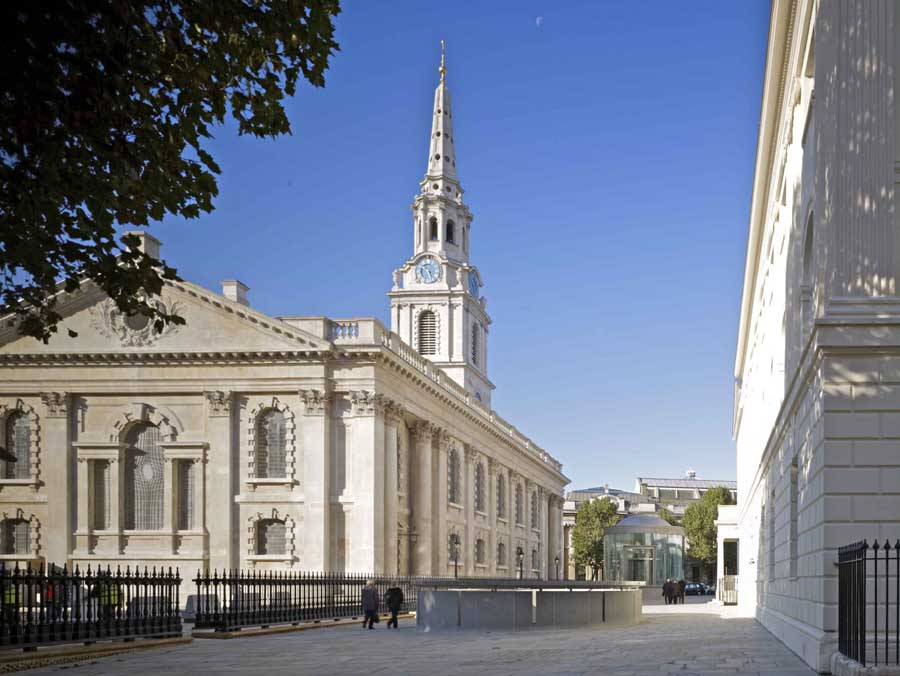Comme Paris, Londres a son Saint-Martin-des Champs: Saint-Martin-in-the-Fields, hommage de la vieille Angleterre à l’évêque de Tours. Proche de Westminster Abbey, de Big Ben et des Maisons du Parlement, en plein Trafalgar Square, l’église de Saint Martin-in-the-Fields évoque le temps où vergers et champs séparaient la Cité de Westminster de la Cité de Londres. Érigée au début du XVIII éme siècle, l’actuelle église Saint-Martin-in-the-Fields, dédiée au culte anglican, remplace deux édifices antérieurs des XIIIe et XVIèmes siècles. Elle est le siège de la célèbre Academy of Saint-Martin-in-the-Fields, ensemble orchestral spécialiste de musique baroque fondé par Sir Neville Marriner en 1958. A l’intérieur du sanctuaire, on lit l’inscription du baptême de Charles II, mais aussi les prénoms de Charles, d’Elisabeth et de Philippe d’Edimbourg… Saint Martin-in-the-Fields est toujours paroisse royale. Le patronage de l’évêque de Tours est inscrit au fronton de l’édifice. Elle a définitivement revêtu son apparence fastueuse au début du XVIIIe siècle. Son clocher domine le quartier tumultueux qui relie Buckingham à Charing Cross. Elle se présente comme un édifice rectangulaire, précédé d’un porche à fronton triangulaire soutenu par des colonnes à chapiteaux corinthiens. Une balustrade ceinture le toit surmonté par un clocher carré dont les trois niveaux sont situés progressivement en retrait les uns des autres; le troisième niveau est orné sur chaque côté d’horloges à fond bleu, avant de se transformer en un petit clocher-tour hexagonal qui s’achève en une flèche également hexagonale. Les armes royales qui figurent aussi bien sur le fronton à l’extérieur qu’au plafond de la voûte intérieure rappellent que la paroisse de Saint-Martin-in-the-Fields englobe le palais de Buckingham.
L’intérieur est éclairé par une double rangée de fenêtres: le premier niveau éclairant les bancs fermés de la nef, le second niveau se caractérisant par de plus hautes ouvertures baignant de lumière de larges tribunes et l’orgue. Les sombres boiseries soigneusement cirées contrastent avec la blancheur des murs et des colonnes; le plafond est orné de motifs en stuc formant caissons. Une double rangée de lustres hollandais ponctue l’allée centrale qui mène au chœur dont certains éléments architecturaux (chapiteaux, frises, arc triomphal) sont dorés.
A côté de Saint Martin in the Fields, on trouve immédiatement Saint Martin’s Street, Saint Martin’s place, Saint Martin’ school of Art, célèbre école de stylisme à Londres, « Saint Martin’s Theatre”, un théâtre Saint-Martin comme à Paris. Détail pittoresque : les colonnes des réverbères du quartier conservent encore « une Charité de saint Martin » en fonte, qui témoigne de la popularité de saint Martin de Tours.
Like Paris, London has its own Saint Martin des Champs: Saint Martin-in-the-Fields, Old England’s tribute to the Bishop of Tours. Close to Westminster Abbey, Big Ben and the Houses of Parliament, in the middle of Trafalgar Square, the church of Saint Martin-in-the-Fields evokes the time when orchards and fields separated the City of Westminster from the City of London. Built in the early 18th century, the present St Martin-in-the-Fields Church, dedicated to Anglican worship, replaces two earlier buildings from the 13th and 16th centuries. It is the home of the famous Academy of Saint-Martin-in-the-Fields, an orchestral ensemble specialising in baroque music founded by Sir Neville Marriner in 1958. Inside the sanctuary is the baptismal inscription of Charles II, as well as the names of Charles, Elizabeth and Philip of Edinburgh… St Martin-in-the-Fields is still a royal parish. The patronage of the Bishop of Tours is inscribed on the pediment of the building. It was finally given its lavish appearance in the early 18th century. Its steeple dominates the bustling area between Buckingham and Charing Cross. It is a rectangular building with a triangular pedimented porch supported by columns with Corinthian capitals. A balustrade surrounds the roof, topped by a square bell tower, the three tiers of which are progressively set back from each other; the third tier is decorated on each side with blue-backed clocks, before transforming into a small hexagonal bell tower which terminates in a hexagonal spire. The Royal Arms on both the exterior pediment and the ceiling of the interior vault are a reminder that the parish of St Martin-in-the-Fields includes Buckingham Palace.
The interior is lit by a double row of windows: the first level illuminating the closed pews of the nave, the second level characterised by taller openings bathing the large galleries and the organ in light. The dark, carefully waxed woodwork contrasts with the white walls and columns; the ceiling is decorated with stucco motifs forming caissons. A double row of Dutch chandeliers punctuates the central aisle leading to the choir, some of whose architectural elements (capitals, friezes, triumphal arch) are gilded.
Next to Saint Martin in the Fields, you will find Saint Martin’s Street, Saint Martin’s Place, Saint Martin’s School of Art, a famous London fashion design school, and Saint Martin’s Theatre, just like in Paris. A picturesque detail: the columns of the lampposts in the area still contain a cast iron « Charity of Saint Martin », which testifies to the popularity of Saint Martin of Tours.

 "/>
"/>

